American Ballet Theatre presents a trilogy of ballets by Alexei Ratmansky to Shostkovich’s music.
When American Ballet Theatre premiered Alexei Ratmansky’s Symphony #9 last October, it was understood that this was to be the first in a trilogy of ballets set to music by Ratmansky’s fellow Russian, Dmitri Shostakovich. That trilogy made its debut with four performances during the company’s spring season at the Met, sandwiched between seven showings of Don Quixote and six of Le Corsaire. Cross your fingers that Ratmansky’s three works will appear again during ABT’s season at the Koch Theater (October 30-November 10).
The choreographer clearly planned the trilogy as if it were one mega-work, with Symphony #9 as its roguish, richly textured first movement, Chamber Symphony as its melancholy second one, and Piano Concerto #1 as its virtuosic flourish of a finale. It’s also clear that Ratmansky hears in Shostakovich’s music references to the composer’s life and allows these to appear subliminally in his choreography.
I wrote about Symphony #9 in detail last year when it premiered on a splendid mixed bill at City Center (https://www.artsjournal.com/dancebeat/2012/10/in-season/) and saw the same terrific cast this time: Craig Salstein as the impudent trickster with Simone Messmer as his partner, Marcelo Gomes and Polina Semionova as the extravagantly romantic couple, and Herman Cornejo as a mysterious presiding sprite—a kind of sober Ariel with soaring jumps and the solitary, spinning-top turns and final fall that bring the curtain down.
The unexpected jocularity and “ideological weakness” of Shostakovich’s 1945 symphony displeased the Soviet authorities; after all, he was supposed to be celebrating the defeat of Nazi Germany, not taking a break from his dark-toned Seventh and Eighth. For sure, sparky altercations between a trombone and a piccolo, like those in the first movement of the Ninth, didn’t suggest the desired topic of victory over evil. Ratmansky’s ingenious ballet takes full advantage of the composer’s changing moods, yet the picture he creates is one of harmony. When Salstein takes a running jump, and four men in the ensemble step forward to catch him, or a group hurries to support Cornejo as he leans dangerously far back, you know you’d like to live in this community (even wear one of Keso Dekker’s effectively re-dyed costumes), despite the occasional intimations of peril. This year, I noticed for the first time how often Ratmansky uses joined hands in this ballet. Couples in the group pull each other on and off the stage like links in search of a larger chain.
Chamber Symphony is the dark, poetic heart of the trilogy. Interestingly, it, too, was not the work Shostakovich was supposed to be writing. In Dresden in 1960 to concoct a film score, he wrote a string quartet instead—his eighth. This quartet was then arranged for string orchestra by violist and conductor Rudolf Barshai, with the composer’s blessing. Shostakovich conceded that his quartet was full of “ideological flaws,” but that the ruins of Dresden, still evident fifteen years after the war’s end, had inspired him. He wrote a friend that Dresden had also made him think of his own eventual death (although he was only 54) and was moved to write a work in memory of himself, a requiem of sorts.
In George Tsypin’s backdrop, huge faces of men cluster, pointing in different directions. At the beginning and end of the ballet, they’re only outlines, but when filled in and brownish, they look grim and sour (a pantheon of remembered adversaries?). It is, I think, the idea of memory that inspired Ratmansky’s approach to his Chamber Symphony.
Shostakovich twined various musical allusions into the fourth movement of his quartet. Musicologists have noted references to other works, including the Dies Irae and an aria from the composer’s own banned 1934 opera, Lady Macbeth of Mtsensk. Ratmansky created a troubled male figure (David Hallberg in the cast I saw) who might be reliving his past. He often reaches out to spaces beyond the stage or agonizes over an inner dilemma—his body crumpling and crooked. Others lay him out when he collapses and the ensemble of four men and eight women watches him in perturbation when he dances fast and furiously. Men pick him up when he falls, but drop him unceremoniously and run offstage, as if they don’t want to be seen assisting him. Their own activities are busy but constrained; the men help their partners into positions as if they were objects to be properly placed.
Three women enter together (Isabella Boylston, Paloma Herrera, and Julie Kent). Hallberg, by the way, is wearing black silk trousers and a matching jacket with a red lining; no shirt. The three wear identical dresses (Dekker designed the costumes for all three ballets) in blue, lavender, or green.
What to make of these women? Muses? Remembered loves or friends? In between the comings and goings of the ensemble, Hallberg dances with each. He and Boylston bow politely to each other, as if just introduced, and soon they’re dancing companionably—in canon, they pirouette and beat their legs together in cabrioles. She slips up behind him and plants a kiss on his cheek; later, they kiss more ardently. After the men have picked Hallberg up and dropped him, the music turns faster (maybe in 6/8 time), the three women dance in fast unison, swaying their hips at Hallberg, and he and Boylston then repeat most of their previous duet, kisses and all, but this time, it ends with her leaning against him and sliding down until she’s seated on the floor.
His relationship with Herrera is more fated. He embraces her; she falls; men lift her and take her away. He’s miserable. Then, through a bit of stage trickery, she materializes out of the ensemble, and he dances with her. She’s mistress of the melting arabesque. In the final startling moments, the four men reach for her, lift her, and throw her into his arms; then they take her back. They do this twice. The music turns hesitant, and he reaches a hand to where she last lay. His duet with Kent is lyrical, tender, but also unfulfilled.
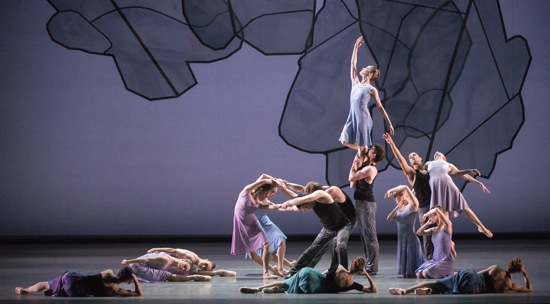
The final tableau of Chamber Symphony. Foreground (L to R): Paloma Herrera, Julie Kent, and Isabella Boylston. Photo: Marty Sohl
Like all good muses, these have strengthened the unhappy hero. In the last part, he takes charge. He pushes the dancers in the ensemble around, breaks them into trios, then directs them to form a tableau. They oblige. The three principal women recline between the audience and the stage picture, watching. But this hero, unlike Balanchine’s Apollo, is no god coming into his own. Slowly, deliberately, Hallberg walks offstage. As he fades away, the group lifts one of its women high, like a victory statue. The curtain falls. I’m still pondering this ballet; perhaps I’ll connect it in my mind to Shostakovich’s sometimes compliant, sometimes rebellious relationship to Stalinist repression and the friends and relatives he lost in the post-1936 purges. Hallberg managed his difficult part magnificently, and the women were expressive and lovely.
Shostakovich wrote his Concerto No. 1 for Piano, Trumpet, and Strings, Op. 35 in 1933. He had just turned 27 when it premiered. The young composer and pianist was admired and respected; his music was played. World War II was in the offing, and Stalin hadn’t yet clamped an iron fist around artistic expression. It’s a happy, witty work, with an interesting relationship between the two solo instruments. There’s a sweet waltz in the second movement, and the third is a downright circus, full of quotes from other composers that you sense, even if it’d take an expert to identify them all.
Ormsby Williams conducted the orchestra for Ratmansky’s Piano Concerto #1, as he did for Chamber Symphony (Charles Barker led the musicians for Symphony #9). Carl Albach was the trumpeter, and Alan Moverman the pianist (both excellent). The piano part is an exercise in virtuosity and a workout for the fingers, especially in the last movement (at the curtain call, the solo musicians appeared to be breathing as hard as the dancers). Ratmansky matched the music’s youthful ebullience with more out-and-out balletic show-stoppers than usual, but, in deference to the composer’s mischievousness, undercut them with small oddities.
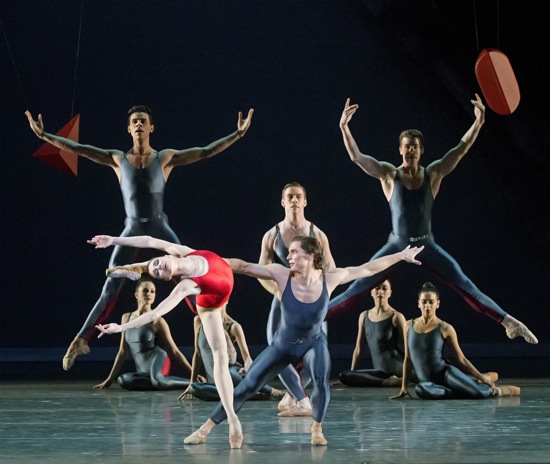
Foreground: Natalia Osipove and Ivan Vasiliev in Ratmansky’s Piano Concerto #1. Photo: Gene Schiavone
In this ballet, as in Symphony #9, Tsypin’s décor alludes to communism. The gray backdrop for the trilogy’s opener is sparely peppered with small, darker gray standing figures, some smaller than others, none very large; amid them are patches of red–flags and other symbols. The décor for Piano Concerto #1 consists of very large red symbols—hammers, sickles, etc.— suspended overhead at different heights, like a slightly ominous version of the mobile you might hang over a crib. The corps of six men and six women dance jauntily and march cheerfully; skipping is a motif. Dekker has dressed them all in shiny unitards—blue-gray in front, red in back. As they turn this way and that, they could be seen as a game of shifting allegiances. As always, Ratmansky deploys his ensemble ingeniously, and, not for the first time, I notice the fleetness of foot that his choreography demands. It’s not just the dance steps that display this speediness; people rush onto the stage as if a train might be leaving and, without a pause, launch themselves into the intricate activities.
Two couples lead the revels (the men wearing all-gray unitards, the women all-red leotards). Natalia Osipova and Ivan Vasiliev are the star athletes in this circus, and they whip off all the required feats with panache. Vasiliev is in his element here and plants a quick kiss on his partner in the middle of their first duet. Diana Vishneva and Cory Stearns begin their duet on the sweet melody with which the strings introduce the concerto’s second movement. They dance side by side, both in unison and individually, but swooning figures importantly. These two are wonderful together in the fluid web of lyricism that Ratmansky has created for them.
The four also function as friends—dancing together, changing partners briefly. Amid the forays by the cadres of men and women, a curious moment occurs. Vishneva appears to wash her face and hands, while Stearns stands ready to help her back into dancing. In the brief third movement and the orderly melee of the fourth, the level of speed and virtuosity zooms kilometers ahead. Vishneva sets the pace by leaping rapidly across, splitting her legs in the air. Shostakovich whips the string ensemble and the solo instruments into a carnival in which the listener is rushed from one attraction to another, veering here, hurried in another direction there. The allusions to other composers surface and get smacked down. The galloping trumpet might be urging on a hunt; an illusory horde of scurrying feet rushes up and down the keyboard.
Things get so crazy that Vishneva and Osipova enter hanging onto each other—lost, perhaps, and a little scared of the powerful human traffic. Fear not ladies, here come your guys, following each other along a diagonal with a sequence of turns in the air, their bodies slanted off the vertical at a 45-degree angle. The red hanging objects begin to rise. The ensemble men carry their women off, poised like leaping stags, their front legs bent. Perhaps in these halcyon days, they’re heading toward that idealized Russian future that was to end so grimly for Shostakovich and so many of his friends and colleagues just three years after he finished this dazzling concerto.

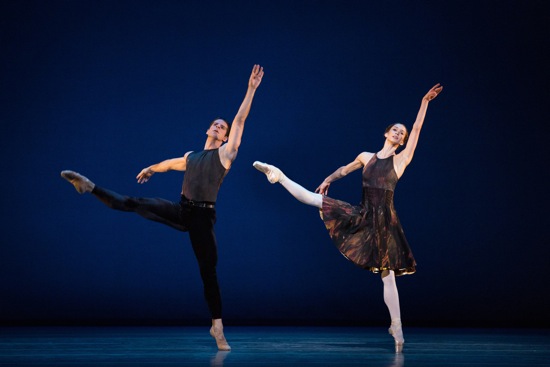
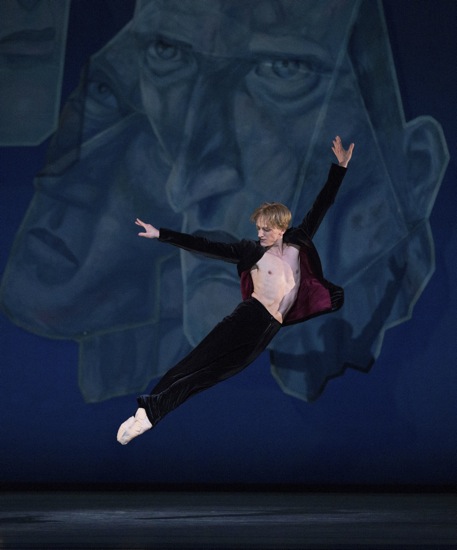
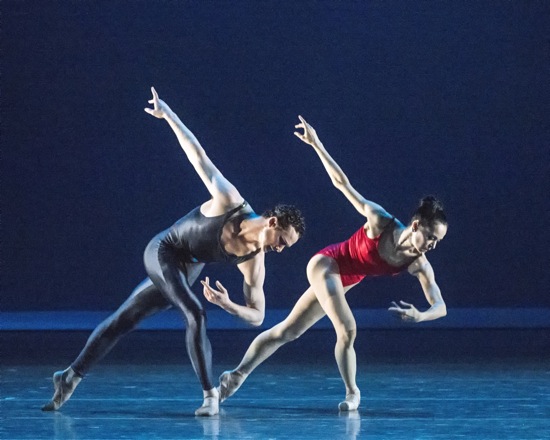
I’m eating my heart out, Deborah–left ventricle is almost gone.
There has been so much discussion in the electronic world about this new work — I am wishing I could be there, but am very grateful for your view of the proceedings!